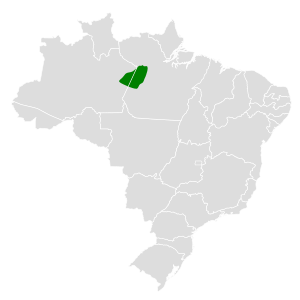Harlequin antbird facts for kids
Quick facts for kids Harlequin antbird |
|
|---|---|
| Conservation status | |
| Scientific classification | |
| Genus: |
Rhegmatorhina
|
| Species: |
berlepschi
|
 |
|
The harlequin antbird (Rhegmatorhina berlepschi) is a special type of bird that lives only in Brazil. It belongs to a bird family called Thamnophilidae. This bird is known for its unique way of finding food. It follows swarms of army ants through the forest. These ants stir up insects and other small creatures from the ground, making them easy for the antbird to catch.
Contents
What is a Harlequin Antbird?
The harlequin antbird is a medium-sized bird. It lives in warm, wet forests, specifically in lowland areas. These birds are very good at finding food because they work with ants. They are called "ant-followers" because they depend on the ants to help them eat.
Where Does It Live?
This bird is endemic to Brazil. This means you can only find it in Brazil and nowhere else in the world. Its home is in the subtropical or tropical moist lowland forests. These forests are usually very dense and full of tall trees, with lots of plants on the ground. The warm, humid climate is perfect for both the antbirds and the army ants they follow.
How Does It Find Food?
The harlequin antbird is a "specialist ant-follower". This means it has a very specific way of getting its meals. It waits for large groups of army ants to move across the forest floor. As the ants march, they scare up all sorts of small creatures. These include insects, spiders, and other arthropods that hide in the leaf litter. The antbird then swoops in and catches these creatures as they try to escape the ants. It's like having a team of tiny helpers doing the hunting for them!
This method of hunting is very efficient. It allows the harlequin antbird to save energy. They don't have to search hard for food themselves. Instead, they let the army ants do the hard work of flushing out prey.
Conservation Status
The harlequin antbird is currently listed as "Least Concern" (LC) by the IUCN. This means that its population is stable. It is not currently at high risk of disappearing. However, protecting its forest habitat is still important. This helps make sure these unique birds continue to thrive in Brazil.
See also
 In Spanish: Hormiguero arlequín para niños
In Spanish: Hormiguero arlequín para niños


